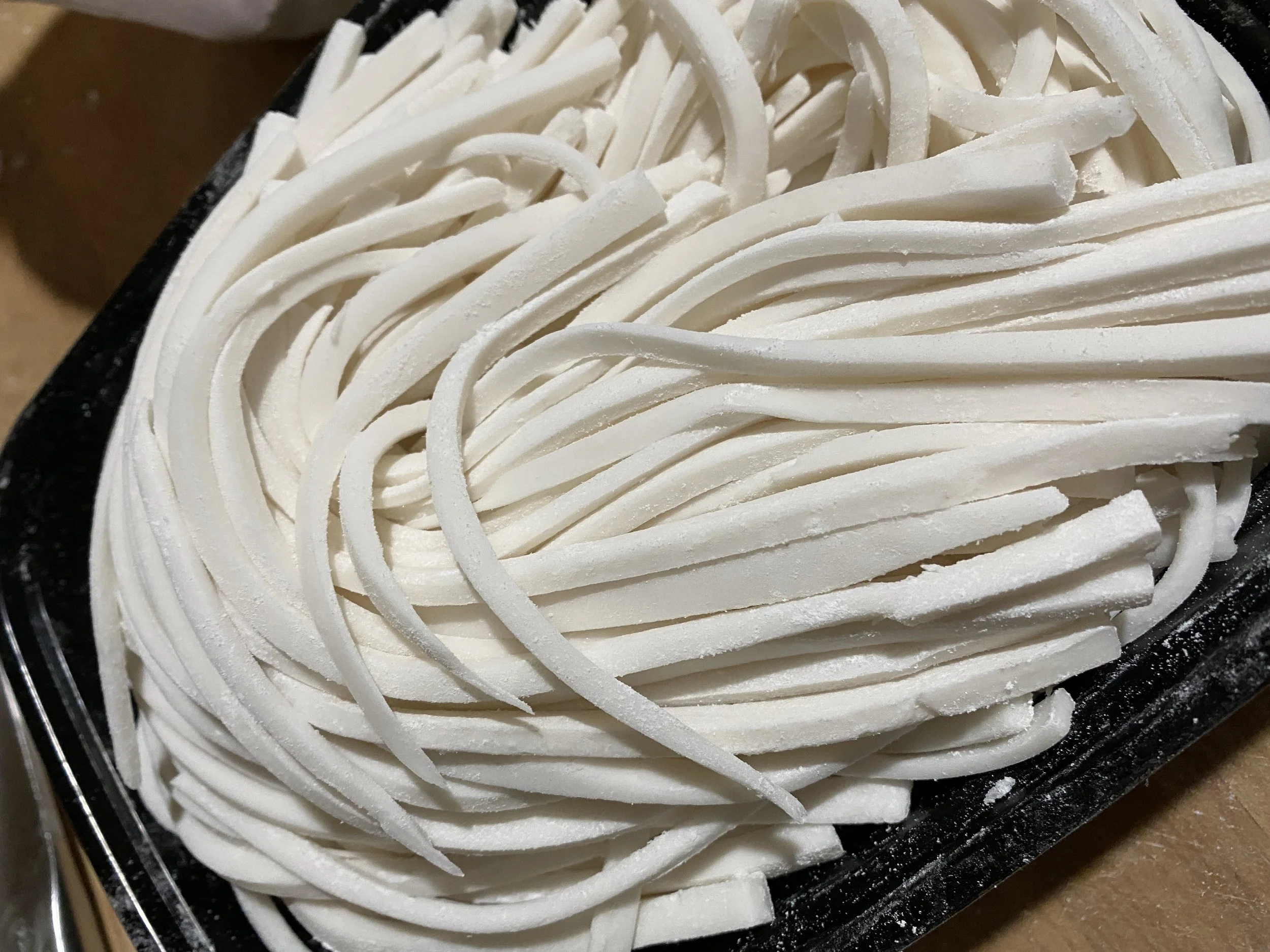Khao Piak Sen | Lao Chicken Noodle Soup
What is Lao chicken noodle soup (khao piak sen)?
Khao piak sen is one of the most popular Lao noodle soups in Laos especially in Vientiane where you can find stalls serving both the noodle and rice versions in the morning. The bowl is filled with freshly hand cut rice tapioca noodles and the broth is a fragrant ginger soup and then its garnished with all your favorite condiments and dipped with khanom kuu (Chinese donut). Below is one of my Lao recipes with different noodle texture variations.
Cultural Significance Of Khao Piak Sen | Lao Chicken Rice Noodle Soup
For most morning foods in Laos, the people enjoy Lao noodle soups like this classic one called khao piak sen. The noodles are made from jasmine rice flour, tapioca flour, and sometimes a little sticky rice flour. Traditionally, the rice grains are manually ground with stones but now adays, rice flour is created with large machines. This Lao food immediately invokes comfort and love as this dish is always served at most Lao households in either noodle form or rice porridge form. It is customizable so people can enjoy it as is or add limes, pork blood cubes, fried garlic and shallots, black pepper, and sometimes pork meatballs.
Ingredients
jasmine rice flour: The rice flour can often be mixed up easily so you want to make sure its jasmine rice flour and not glutinous rice flour as both are very different.
tapioca flour: This is one of the most important ingredients in the noodle since it provides the extra chewy texture and keeps the dough together.
Water: The water should be boiling hot when mixed with the rice flours.
cooking oil: Use any neutral cooking oil.
Garlic and shallots: used to bring out the flavors when its fried in the oil.
yellow onion: Its important to let the onion cook and fuse into the broth.
cilantro roots (or cilantro stems): a more difficult ingredient to find and often seen at the farmers market. If you can’t find the roots, the thick bottom of the cilantro stems should be fine.
Galangal: This recipe uses galangal but you can also use ginger as an alternative.
lemongrass stalk: Another aromatic that adds a great aroma to the broth.
lime leaves: Make sure to crush the leaves with your hands and then add it to the broth.
whole small chicken or 6 chicken thighs: The best is using a whole chicken as its more flavor and you get different textures from the different chicken parts.
fish sauce: build the level of flavor.
Kosher Salt and black pepper: Add more flavor to the broth.
Garnish: lime, fried garlic, fried shallots, chili oil, more fish sauce to taste, cilantro, green onions, and sriracha
Purpose of using Kaffir Lime Leaves
Kaffir lime leaves in broths add a great aroma to the broth. Make sure the leaves are gently crumbled to release the flavors. Once the broth finishes cooking, they can be discarded as it's too strong to eat alone.
Why boiling water is important for the recipe
One of the most common mistakes when making the noodles is not using boiling water. Oftentimes people use warm water or even room temperature water which prevents the tapioca starch from forming a sticky consistency to fuse the dough together. Boiling water is hard to work with so its recommended to mix the flours with a wooden spoon at first until its well mixed and the dough cools down. The dough should then be squeezed together to make sure the dough forms well. If the dough is still not coming together, you can add a tablespoon of hot water until it forms the dough but make sure not to add too much water or the noodles will fall apart when cooking the noodles.
Equipment used to mix the rice flour
For the traditional way, you can mix the flour in a large bowl with a wooden spoon. If your hands are sensitive, you can use a machine mixer as it can mix a large amount of flour while the water is hot creating a more consistent dough.
What type of rice flour should I use?
There is some confusion when it comes to the flour, so make sure to always use jasmine rice flour for the majority of the mixture. Sticky rice flour will not work as it is too sticky but you can add a little bit of the sticky rice flour for different textures. I suggest getting the rice flour from Southeast Asian markets (specifically the Erawan Brand) as other brands of rice flours don’t work the same.
Types of Rice Noodles Used
The signature noodles always have a chewy texture coming mostly from the tapioca flour. If you are running low on time, one of the common hacks and substitutions for the tapioca rice noodles is using udon noodles as it resembles the noodles. In many Lao restaurants in Laos, you will notice the common thin tapioca rice noodles that are now mass produced so its not the common household cut noodles.
How to perfectly cut the rice noodles?
If you have the time, you can cut each noodle one by one with a sharp knife. Another way to cut the noodles is through a noodle machine attachment like a Kitchen Aid. My preference to cutting khao piak sen noodles is with a handheld cutter as the noodles always come out perfectly. See the recipe below with the link to the perfect noodle cutter to save you time and also impress your friends.
Variations Of The Dish In Different Regions Of Laos
There are several variations of khao piak sen all over Laos. This is what you can find and expect. Most Lao restaurants in Laos always serve machine made thin tapioca rice noodles that almost resemble thick vermicelli noodles. The second type of noodle are the hand cut noodles found at the morning markets made by local families. The third type of noodle are the extra large tapioca rice noodles also known as khao piak khao sen yai that are almost like long Korean rice cakes. Most of the morning stalls use a gigantic stock pot that has the noodles already cooked in the broth so most often the noodles are more soft as they have been sitting in the broth all morning.
Health Benefits of Khao Piak Sen
One of the main reasons why khao piak sen is eaten in the morning is because it's filling and prepares workers for the day while still giving you a very healthy broth made from usually chicken and ginger. This is also another reason why people enjoy this dish even more when they are sick as the ginger chicken broth is healing. If you have a stomach ache, most times this noodle soup dish will cure you fast.
Serving Suggestions And Popular Accompaniments
The typical khao piak sen is served plain with the broth, noodles, chicken strips, and sometimes pork blood cubes. It depends on the person, but sometimes people like a thick broth with the noodles cooked in the broth or a thin broth wit the noodles cooked in a separate pot. You can ask for an added poached egg and khanom kuu which is a small cylinder donut great for dipping in the broth. For many Lao people, they love it extra spicy so the broth will be a vibrant red color from the chili oil. One of the best chili oil to add in this broth is the popular pork rind chili oil as it gives the crunch and spice to the dish. Lastly, lots of green onion and cilantro is garnished to freshen it up.
Tips & Tricks in making the best Lao chicken noodle soup khao piak sen
The more you make khao piak sen, the better you will get at it.
make the best noodles by using boiling hot water and also kneading the dough together very tightly
don’t add too much water or else your noodles will fall apart
use bone in chicken pieces as it will help create a delicious chicken bone broth
freshly fried garlic and shallots make a big difference in the broth
buy freshly made khanom khuu (Chinese donuts) to save you time
If you want extra vegetables in your soup, people sometimes add blanched morning glory to each bowl
Watch on Youtube

Khao Piak Sen | Lao Chicken Noodle Soup
Ingredients
Instructions
- In a large bowl, add the rice flour and tapioca flour then whisk.
- Add boiling hot water to the flour mixture and quickly mix
- The mixture will look dry but keep mixing with the spoon until it is warm enough to touch with your hands
- Knead with the hands and press all the flours together. The dough should be firm. If the dough is crumbly, add a tbsp of hot water and knead until it becomes a ball.
- Sprinkle area with rice flour then roll out the dough and dust with extra rice flour
- Cut off the rough edges then cut in half and half again
- Stack layers on top of each other then cut into desired noodle consistency. Dust with extra rice flour. Wrap in plastic wrap if you’re not cooking it right away.
- Cook noodles for about 2-3 minutes in boiling water
- Prepare the broth aromatics: lightly crush the garlic, minced shallots, halved yellow onion, bruised cilantro roots, bruised galangal slices, bruised lemongrass, lightly squeezed lime leaves.
- Cut up the whole chicken with bone on.
- In the pot, heat the stove on high then add the cooking oil. Add the aromatics; saute the aromatics until lightly golden.
- Add the chicken pieces and saute until the skin browns then add the water before aromatics start burning.
- Season with fish sauce, black pepper, and salt.
- Bring the broth to a boil then let it simmer and cover with a lid for 1 hour.
- Strain the broth out and hand shred the chicken meat.
- Place the cooked noodles into a serving bowl.
- Add the desired amount of broth.
- Garnish with lime, fried garlic, fried shallots, chili oil, more fish sauce to taste, cilantro, green onions, and sriracha












Sabaidee, I’m Saeng!
I’m a personal chef who specializes in Lao food. Here at Saeng’s Kitchen, you’ll find all your favorite traditional Lao foods and also some new twists to Lao style dishes.